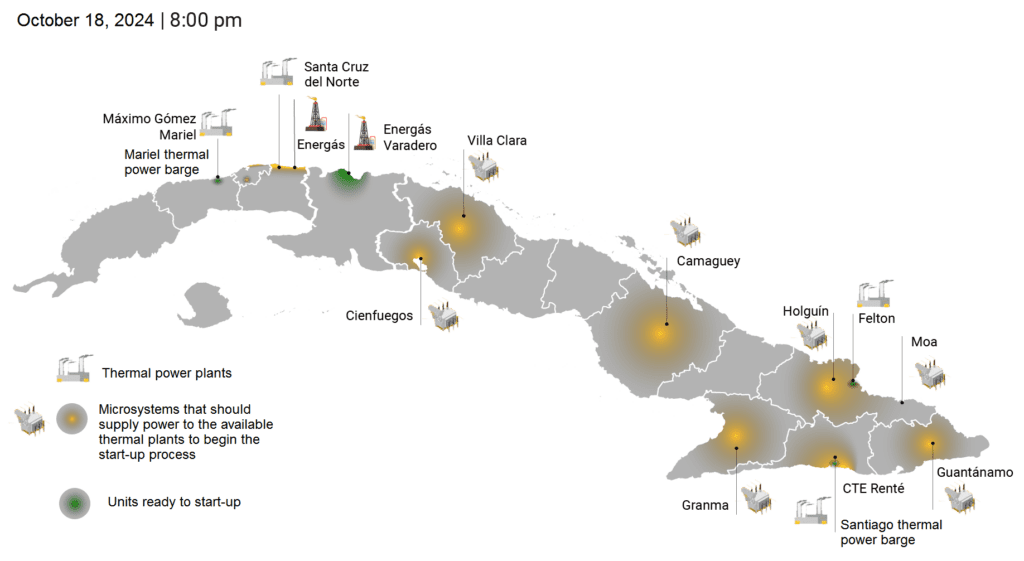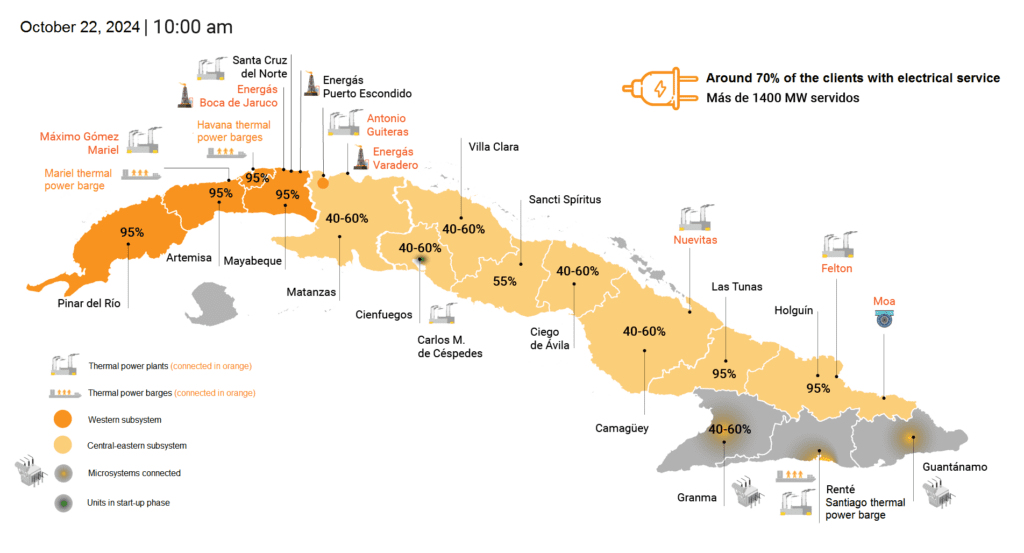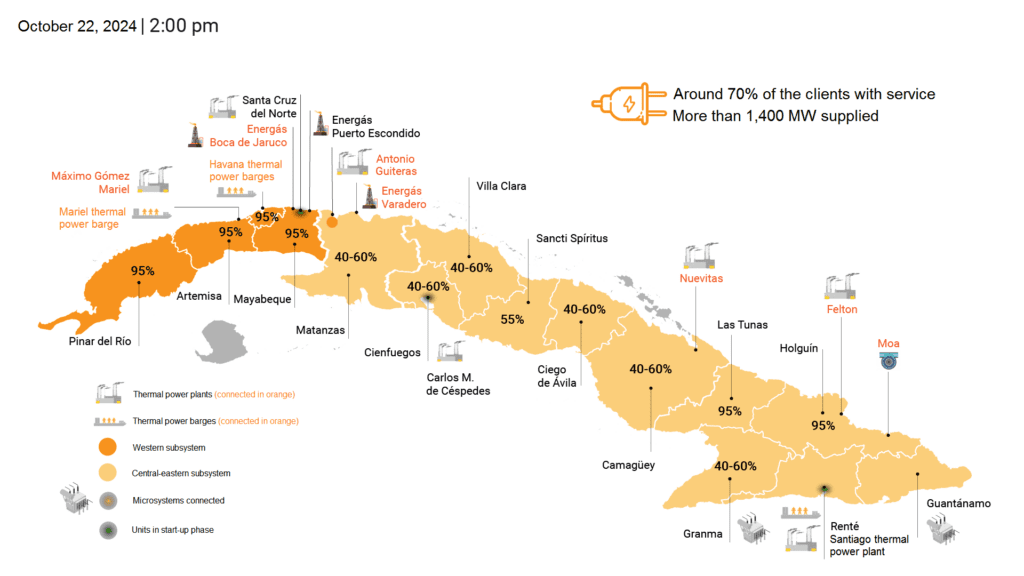A Breakdown of Cuba’s Grid Collapse and Recovery Efforts
Cuba is in the throes of a severe energy crisis, driven by fuel supply disruptions and compounded by obstacles in securing vital technologies and supplies needed to modernize and operate its aging power plants. The situation, exacerbated by U.S. sanctions, has left the nation’s energy system teetering. At the same time, the island nation is grappling with recovery efforts in the aftermath of Hurricane Oscar, which ravaged the eastern region, leaving seven dead and devastating infrastructure across four municipalities in Guantánamo province.
The country’s power grid collapsed on Friday, Oct. 18, due to the failure of one of the island’s largest thermal power plants—the 330-MW Antonio Guiteras thermoelectric plant in Matanzas province—hours after the island suffered its biggest power outage in two years on the night of Oct. 17. The Ministry of Energy and Mines (MINEM) reported in a message on X that the National Electric System (SEN) at 11 a.m. was “completely disconnected” following the unexpected shutdown of the oil-fired power plant.
Tras la salida imprevista de la CTE Antonio Guiteras, a las 11 de mañana de hoy se produjo la desconexión total del Sistema Electroenergético Nacional. La Unión Eléctrica trabaja en su restablecimiento.
— Ministerio de Energía y Minas de Cuba 🇨🇺 (@EnergiaMinasCub) October 18, 2024
Aid and Recovery Has Begun
About 40.6% of Cuba’s power generation is produced in thermal power plants, 21.7% with fuel oil engines, and 21.9% with diesel engines. Almost 8% is produced with the accompanying gas from oil production, 5% comes from renewable energy sources (hydro, solar, and wind), and the remaining 3% is produced by floating units (thermal power barges). As POWER has reported, Cuba’s power system has faced increasing strain since 2021, with blackouts becoming more frequent due to accidents at key generation units and aging thermal power plants. Thermal plants are outdated, with most surpassing their 30-year lifespan. Frequent breakdowns, compounded by the corrosive effects of high-sulfur Cuban crude oil, have led to more frequent maintenance needs. In response, Cuba has launched a recovery plan aimed at restoring 489 MW of power by the end of 2023 through upgrades and investments, but the system continues to struggle without sufficient reserve capacity, prolonging blackouts.
[Editor’s note: The U.S. blockade on Cuba, a longstanding policy, continues to affect the island’s economy, limiting its access to resources and technologies necessary for infrastructure development, including the power sector, according to much of the international community. During an Oct. 21 White House press conference, Press Secretary Karine Jean-Pierre addressed the recent power outages in Cuba, clarifying that while the U.S. is monitoring the situation closely, the Cuban government has not requested any assistance. “Cuba’s economic condition stemming from long-term mismanagement of its economic policy and resources has certainly increased the hardship of the people in Cuba,” she said. “The U.S. is not to blame for the blackouts on the island or the overall energy situation in Cuba,” she claimed.]
A Dramatic Collapse
On Friday, Oct. 18, Lázaro Guerra, director of Electricity of the MINEM, said on Cuban television that the restoration process was ongoing. “At this moment, we have microsystems in all provinces except Artemisa, where limited power is reaching nearby consumers,” he said. He also noted that the Energas plant was already operational, and power was being restored in Santa Cruz del Norte, which was in the process of starting up.

In western Havana, efforts were focused on restarting the Mariel thermal power plant, where all three units were operational, unlike other plants. Work was underway to connect the plant to the grid through a thermal power barge or Havana’s network, which had electricity at certain substations, such as Naranjito, providing another possible route to Mariel. “Once we have Mariel connected to Energas and Santa Cruz del Norte, this will benefit the western area, which is a priority. Work is also being carried out on the collapse of the Antonio Guiteras thermoelectric plant,” Guerra explained.
In the east, power was restored at the Renté power plant, enabling work on its two units to incorporate them into the system. Additionally, one engine from a thermal power barge had started up. “We already have energy in Moa, which will allow us to create a microsystem, and we will continue to do so in each territory. In Nuevitas, we are working to resolve an issue, and in Camagüey province, we are establishing a microsystem to supply energy,” he added.
Guerra also reported that Felton 1 had been successfully restarted. In the central region, distributed generation enabled power generation, and Energas Varadero further strengthened the national electric system. The increased stability in microsystems was expected to facilitate the interconnection of systems, eventually leading to the restoration of the national grid. He confirmed that the necessary workforce and specialists were in place across all territories, ensuring that the restoration work would be completed with high quality in the shortest time possible.
On the same day, Guerra told Cuban television that the causes of the Antonio Guiteras thermoelectric plant outage, which led to the collapse of the national grid, were still under investigation. “At this moment, each of the thermoelectric units is being reviewed for restoration,” he said. He also noted that the restoration process had begun with the Energás Puerto Escondido plant, which was already generating electricity using natural gas. “Later, work will be done to also connect the Energás plant at Boca de Jaruco,” he added.
Guerra explained that to synchronize each of the thermal units, microsystems, or “islands,” were being created with the distributed generation units in various territories. These microsystems would bring power to the thermoelectric plants, with priority given to generators located near the thermal blocks. Meanwhile, state-owned CUPET was distributing the necessary fuel to ensure continued generation.
“There is no set timeline for full restoration, but efforts are underway to reconnect the electrical system as soon as possible,” Guerra concluded.
A Timeline of Restoration
In the last 24 hours, Cuba has made significant strides in restoring electricity:
7:54 a.m.: Felton 1, part of the Lidio Ramón Pérez thermal power plant in Holguín province, was synchronized with the national grid, marking an important step toward stabilizing power after the total system disconnection on October 18.
8:09 a.m.: 65 MW of power was restored to Pinar del Río province, which is now connected to the western system extending to Matanzas.
8:25 a.m.: 70.89% of Cuban customers had electricity, according to a report from the Ministry of Energy and Mines via X (formerly Twitter).
8:38 a.m.: The western subsystem was consolidated, with no service problems from Pinar del Río to parts of Matanzas. However, the demand exceeds capacity, meaning load management will be necessary once the national grid is restored. Units 6 of Nuevitas and 1 of Felton, as well as engines in Moa, started generating power. Unit 4 of the CTE Carlos Manuel de Céspedes in Cienfuegos was in the process of starting up.
9:42 a.m.: Unit 4 of the Carlos Manuel de Céspedes plant in Cienfuegos began its start-up process.
10:03 a.m.: The Máximo Gómez thermal power plant had all three units operational, powering the microsystem in western Cuba.
10:11 a.m.: According to the Union Eléctrica (UNE), over 95% of customers in Pinar del Río, Artemisa, Havana, Mayabeque, Las Tunas, and Holguín had power. Between 40% and 60% of customers in Matanzas, Cienfuegos, Villa Clara, Sancti Spíritus, Ciego de Ávila, Camagüey, and Granma had service, while Santiago de Cuba and Guantánamo had the lowest availability. Around 70% of Cuba had electricity, serving more than 1,400 MW.
1:34 p.m.: Santiago de Cuba, Guantánamo, and Granma provinces were connected to the central-eastern system. The Energás Boca de Jaruco unit began starting up, with unit 6 of Renté and unit 4 of the CTE Carlos Manuel de Céspedes also expected to come online.
3:53 p.m.: The national electrical system was fully synchronized by 2:44 p.m., though a 1,060 MW deficit was projected for the peak on October 24.


Ongoing Issues and Projections
According to the latest report from the Electric Union, a deficit of 1,060 MW is expected during the evening peak on Thursday, Oct. 24. On Wednesday, service was disrupted by insufficient generation capacity. Though power was restored by 3:34 a.m., by 5:48 a.m. service was once again affected due to generation shortages.
The highest impact occurred at 6:30 p.m. with a 1,245 MW shortfall during peak hours. Additionally, 17 MW were reported out in Guantánamo as a result of the hurricane.
As of 7:00 a.m., system availability (SEN) stood at 1,990 MW, while demand reached 2,160 MW, leaving 220 MW offline due to capacity limitations. An average shortfall of 450 MW is anticipated throughout the day.
Several key thermal power plants are offline: Unit 8 of Mariel TPP, Unit 3 of Cienfuegos TPP, and Unit 2 of Felton TPP are down, while Unit 2 of Santa Cruz TPP and Unit 5 of Renté TPP are under maintenance.
Thermal generation capacity is currently reduced by 724 MW, and 24 distributed generation plants are offline due to fuel shortages, affecting an additional 135 MW. For peak hour demand, the reactivation of Unit 8 at Mariel TPP, expected to add 70 MW, is currently underway.
Forecasts indicate a peak-hour demand of 3,050 MW, with available capacity at 1,990 MW, leaving a projected shortfall of 990 MW. If these conditions persist, the impact could rise to 1,060 MW.
—Amaury Pérez Sánchez ([email protected]) is a chemical engineer based in Cuba with the University of Camagüey.